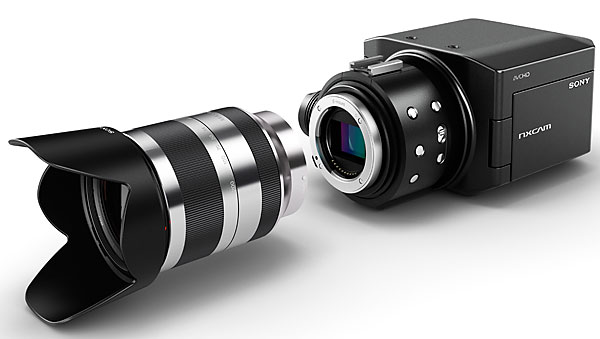20mm pancake for NEX from Sony
It’s not the fast f/2 design everyone was hoping for, but maybe the quality will be right – Sony has announced a new 20mm f/2.8 pancake lens for NEX. At the same time, the power zoom first seen at photokina, aimed at video NEX models, is available separately.
Here is the release:
Photographers and video makers are spoilt for choice with two additions to the range of E-mount interchangeable lenses for SonyαE-mount cameras and semi-professional camcorders.
E 20mm F2.8 ‘pancake’ wide-angle lens
Measuring approximately 20mm from front to back, this short focal length ‘pancake’ lens makes an ultra-slim yet tough ‘walkaround’ partner for your α E-mount camera.
With the 35mm equivalent of its 30mm wide-angle view and bright F2.8 aperture, it’s perfect for a broad range of everyday shooting opportunities, from interiors to landscapes, street scenes and casual snaps. Excellent contrast and resolution are also augmented by enhanced clarity in corner areas to satisfy the most discerning photographer.
E PZ18-200mm F3.5-6.3 OSS powered telephoto zoom lens
Offering a generous 11x magnification range, this high-quality telephoto zoom makes an ideal partner for shooting video with the E-mount interchangeable lens Full HD camcorders. The NEX-VG30EH is already supplied as a kit with the E PZ 18-200mm F3.5-6.3 OSS power zoom lens.
A comfortably positioned zoom lever is partnered with a switch on the lens barrel, allowing zoom speed to be selected in six steps, from slow, beautiful shifts in perspective to dramatic crash-zoom effects. Thanks to a newly developed internal linear motor, power zoom is complemented by exceptionally smooth focusing and aperture operation. Zoom can also be controlled directly from NEX-VG900, NEX-VG30 and NEX-FS700*.
*Firmware update is required for NEX-FS700.
Built-in Optical SteadyShot cuts the effects of camera shake, allowing handheld use of slower shutter speeds without image blur. Active Mode further enhances stabilisation at the wide end of the 11x zoom range – even when you’re walking along – making the lens a compelling choice for capturing smooth, stable video footage.
While optimised for video, it’s also a flexible choice for shooting stills with Sony’sαE-mount interchangeable lens,, from expansive landscapes to high impact close-ups of wildlife and athletes
E-mount lens family keeps growing
There’s now a family of thirteen E-mount lenses plus two converters, covering virtually any shooting situation with your Sony α E-mount camera or camcorder. Spanning ultra-wide angle,powerful telezoom, macro and fast, bright primes, the range includes premium optics by Sony and Carl Zeiss. Beautifully styled to complement yourαE-mount camera, every E-mount lens offers refined performance and easy handling.
The new Sony E 20mm F2.8 interchangeable lens will be available from March 2013,and the E PZ18-200mm F3.5-6.3 OSS lens from February 2013.



